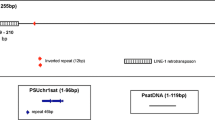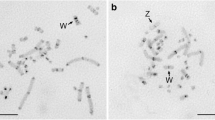Abstract
We molecularly cloned new families of site-specific repetitive DNA sequences from BglII- and EcoRI-digested genomic DNA of the Syrian hamster (Mesocricetus auratus, Cricetrinae, Rodentia) and characterized them by chromosome in situ hybridization and filter hybridization. They were classified into six different types of repetitive DNA sequence families according to chromosomal distribution and genome organization. The hybridization patterns of the sequences were consistent with the distribution of C-positive bands and/or Hoechst-stained heterochromatin. The centromeric major satellite DNA and sex chromosome-specific and telomeric region-specific repetitive sequences were conserved in the same genus (Mesocricetus) but divergent in different genera. The chromosome-2-specific sequence was conserved in two genera, Mesocricetus and Cricetulus, and a low copy number of repetitive sequences on the heterochromatic chromosome arms were conserved in the subfamily Cricetinae but not in the subfamily Calomyscinae. By contrast, the other type of repetitive sequences on the heterochromatic chromosome arms, which had sequence similarities to a LINE sequence of rodents, was conserved through the three subfamilies, Cricetinae, Calomyscinae and Murinae. The nucleotide divergence of the repetitive sequences of heterochromatin was well correlated with the phylogenetic relationships of the Cricetinae species, and each sequence has been independently amplified and diverged in the same genome.















Similar content being viewed by others
References
Arrighi FE, Hsu TC, Pathak S, Sawada H (1974) The sex chromosomes of the Chinese hamster: constitutive heterochromatin deficient in repetitive DNA sequences. Cytogenet Cell Genet 13:268–274
Bishop CE, Boursot P, Baron B, Bonhomme F, Hatat D (1985) Most classical Mus musculus domesticus laboratory mouse strains carry a Mus musculus musculus Y chromosome. Nature 315:70–72
Essers J, de Stoppelaar JM, Hoebee B (1995) A new rat repetitive DNA family shows preferential localization on chromosome 3, 12 and Y after fluorescence in situ hybridization and contains a subfamily which is Y chromosome specific. Cytogenet Cell Genet 69:246–252
Fátyol K, Cserpán I, Praznovszky T, Kereső J, Hadlaczky G (1994) Cloning and molecular characterization of a novel chromosome specific centromere sequence of Chinese hamster. Nucleic Acids Res 22:3728–3736
Gabrielian A, Simoncsits A, Pongor S (1996) Distribution of bending propensity in DNA sequences. FEBS Lett 393:124–130
Garagna S, Redi CA, Capanna E, Andayani N, Alfano RM, Doi P, Viale G (1993) Genome distribution, chromosomal allocation, and organization of the major and minor satellite DNAs in 11 species and subspecies of the genus Mus. Cytogenet Cell Genet 64:247–255
Graphodatsky AS, Sablina OV, Meyer MN, Malikov VG, Isakova EA, Trifonov VA, Polyakov AV, Lushnikova TP, Vorobieva NV, Serdyukova NA, Perelman PL, Borodin PM, Benda P, Frynta D, Leikepová L, Munclinger P, Piálek J, Sádlová J, Zima J (2000) Comparative cytogenetics of hamsters of the genus Calomyscus. Cytogenet Cell Genet 88:296–304
Hamilton MJ, Hong G, Wichman HA (1992) Intragenomic movement and concerted evolution of satellite DNA in Peromyscus: evidence from in situ hybridization. Cytogenet Cell Genet 60:40–44
Hörz W, Altenburger W (1981) Nucleotide sequence of mouse satellite DNA. Nucleic Acids Res 9:683–696
Karpova OI, Penkina MV, Dadashev SY, Milshina NY, Hernandes J, Radchenko IV, Bogdanov YF (1995) Primary structure of golden-hamster synaptonemal complex DNA. Mol Biol 29:289–295
Lapeyre J, Beattie W, Dugaiczyk A, Vizard D, Becker F (1980) EcoRI-generated reiterated components of the rat genome. I. Sequence of two (92 and 93 bp) related DNA fragments. Gene 10:339–346
Li S, Pathak S, Hsu TC (1982) High resolution G-banding patterns of Syrian hamster chromosomes. Cytogenet Cell Genet 33:295–302
Marchal JA, Acosta MJ, Bullejos M, de la Guardia RD, Sánchez A (2003) Sex chromosomes, sex determination, and sex-linked sequences in Microtidae. Cytogenet Genome Res 101:266–273
Matsuda Y, Chapman VM (1995) Application of fluorescence in situ hybridization in genome analysis of the mouse. Electrophoresis 16:261–272
Matsuda Y, Harada YN, Natsuume-Sakai S, Lee K, Shiomi T, Chapman VM (1992) Location of the mouse complement factor H gene (cfh) by FISH analysis and replication R-banding. Cytogenet Cell Genet 61:282–285
Mayorov VI, Rogozin IB, Adkison LR (1999) Characterization of several LINE-1 elements in Microtus kirgisorum. Mamm Genome 10:724–729
Michaux J, Reyes A, Catzeflis F (2001) Evolutionary history of the most speciose mammals: molecular phylogeny of muroid rodents. Mol Biol Evol 18:2017–2031
Modi WS (1992) Nucleotide sequence and genomic organization of a tandem satellite array from the rock vole Microtus chrotorrhinus (Rodentia). Mamm Genome 3:226–232
Modi WS, Serdyukova NA, Vorobieva NV, Graphodatsky AS (2003) Chromosomal localization of six repeated DNA sequences among species of Microtus (Rodentia). Chromosom Res 11:705–713
Neitzel H, Kalscheuer V, Henschel S, Digweed M, Sperling K (1998) Beta-heterochromatin in mammals: evidence from studies in Microtus agrestis based on the extensive accumulation of L1 and non-L1 retroposons in the heterochromatin. Cytogenet Genome Res 80:165–172
Neitzel H, Kalscheuer V, Singh AP, Henschel S, Sperling K (2002) Copy and paste: the impact of a new non-L1 retroposon on the gonosomal heterochromatin of Microtus agrestis. Cytogenet Genome Res 96:179–185
Ouspenski II, Brinkley BR (1993) Centromeric DNA cloned from functional kinetochore fragments in mitotic cells with unreplicated genomes. J Cell Sci 105:359–367
Pech M, Igo-Kemenes T, Zachau HG (1979) Nucleotide sequence of a highly repetitive component of rat DNA. Nucleic Acids Res 7:417–432
Pietras DF, Bennett KL, Siracusa LD, Woodworth-Gutai M, Chapman VM, Gross KW, Kane-Haas C, Hastie ND (1983) Construction of a small Mus musculus repetitive DNA library: identification of a new satellite sequence in Mus musculus. Nucleic Acids Res 11:6965–6983
Popescu NC, DiPaolo JA (1972) Identification of Syrian hamster chromosomes by acetic–saline–Giemsa (ASG) and trypsin techniques. Cytogenetics 11:500–507
Popescu NC, DiPaolo JA (1979) Heterogeneity of constitutive heterochromatin in somatic Syrian hamster chromosomes. Cytogenet Cell Genet 24:53–60
Popescu NC, DiPaolo JA (1980) Chromosomal interrelationship of hamster species of the genus Mesocricetus. Cytogenet Cell Genet 28:10–23
Ray M, Mohandas T (1976) Proposed banding nomenclature for the Chinese hamster chromosomes (Cricetulus griseus). Cytogenet Cell Genet 16:83–91
Sambrook J, Fritsch EF, Maniatis T (1989) Molecular cloning: a laboratory manual, 2nd edn. Cold Spring Harbor Laboratory Press, New York
Schmid M, Haaf T, Weis H, Schempp W (1986) Chromosomal homoeologies in hamster species of the genus Phodopus (Rodentia, Cricetinae). Cytogenet Cell Genet 43:168–173
Sealy L, Hartley J, Donelson J, Chalkley R, Hutchison N, Hamkalo B (1981) Characterization of a highly repetitive sequence DNA family in rat. J Mol Biol 145:291–318
Singer MF (1982) Highly repeated sequences in mammalian genomes. Int Rev Cyt 76:67–112
Steppan SJ, Adkins RM, Anderson J (2004) Phylogeny and divergence-date estimates of rapid radiations in muroid rodents based on multiple nuclear genes. Syst Biol 53:533–553
Sumner AT (1972) A simple technique for demonstrating centromeric heterochromatin. Exp Cell Res 75:304–306
Acknowledgements
This study was supported by a Grant-in-Aid for Scientific Research (No. 16086201) from the Ministry of Education, Culture, Sports, Science and Technology in Japan.
Author information
Authors and Affiliations
Corresponding author
Additional information
Communicated by Y. Hiraoka
Rights and permissions
About this article
Cite this article
Yamada, K., Kamimura, E., Kondo, M. et al. New families of site-specific repetitive DNA sequences that comprise constitutive heterochromatin of the Syrian hamster (Mesocricetus auratus, Cricetinae, Rodentia). Chromosoma 115, 36–49 (2006). https://doi.org/10.1007/s00412-005-0012-x
Received:
Revised:
Accepted:
Published:
Issue Date:
DOI: https://doi.org/10.1007/s00412-005-0012-x




